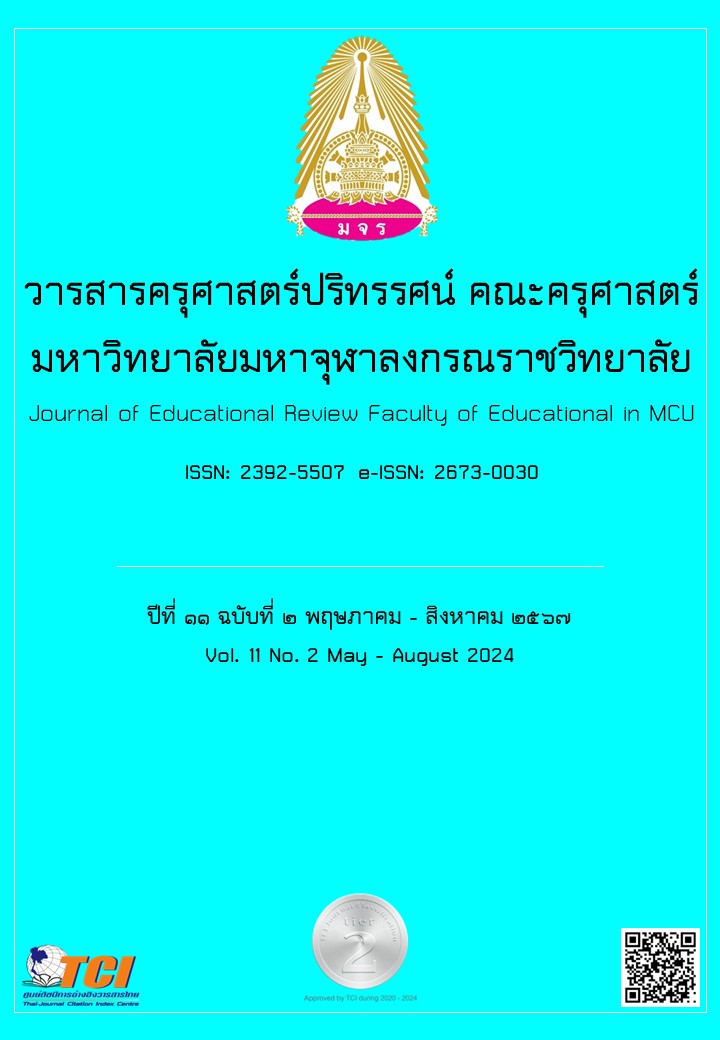MODEL FOR PROMOTING HAPPY LEARNING ACCORDING TO THE PRINCIPLES OF MAGGA FOREGOING SIGNS OF SCHOOL ADMINISTRATORS UNDER OFFICE OF PATHUM THANI SECONDARY EDUCATIONAL SERVICE AREA AUSAL
Main Article Content
Abstract
The objective of this research article were 1) to study components of promoting happy learning according to the principles of Magga Foregoing Signs of school administrators under office of Pathum Thani secondary educational service area, 2) to develop and examine the validity a model for promoting happy learning according to the principles of Magga Foregoing Signs of school administrators under office of Pathum Thani secondary educational service area, and 3) to evaluate the model for promoting happy learning according to the principles of Magga Foregoing Signs of school administrators under office of Pathum Thani secondary educational service area. Multiphase mixed methods research was designed and was divided into 3 steps. Step 1 was qualitative research using In-depth interviews with 12 administrators qualified individuals selected through purposive sampling. Step 2 was quantitative research using questionnaires to examine the validity of model by data collecting from 265 samples analyzed by descriptive statistics, Pearson's Correlation Coefficient and analyzed to validate the model with the empirical data. Step 3 was qualitative research using focus group discussion with 9 experts of qualified school administration analyzing data through content analysis, and content validity index was designed by assessing from 5 school administrators and data was analyzed value of content validity index. Results were shown as follows: 1) The components of promoting happy learning according to the principles of Magga Foregoing Signs of school administrators under office of Pathum Thani secondary educational service area consisted of five main components which were (1) learner characteristics and attributes, (2) teacher preparedness of teaching , (3) learning environment and atmosphere, (4) the principles of Magga Foregoing Sign components, (5) happy learning. 2) A model for promoting happy learning according to the principles of Magga Foregoing Signs of school administrators under office of Pathum Thani secondary educational service area was developed, it had important factors and was a causal relationship model that effected to happy learning. The model consisted of 5 factors which were (1) learner characteristics and attributes, (2) teacher preparedness of teaching , (3) learning environment and atmosphere, (4) the principles of Magga Foregoing Sign components, and (5) happy learning, and fit with empirical data (Chi-square = 179.37, df = 128, p = .0518, GFI = 0.952, AGFI = 0.945, RMR = 0.191). The values of R-SQUARE of happy learning (LH) was 0.776, it indicated that the model variables in learner characteristics and attributes (SA), teacher preparedness of teaching (TR), learning environment and atmosphere (EV) and the principles of Magga Foregoing sign components (DH) could explain the variant of happy learning (LH) at 77.6%. In addition, the principles of Magga Foregoing sign components was a mediator of the developed model. 3) The model for promoting happy learning according to the principles of Magga Foregoing Signs of school administrators under office of Pathum Thani secondary educational service area was evaluated by focus group discussion found that all factors were appropriate. Results of content validity index showed that the developed model was appropriate, accurate, possible to practice, and could be used for utilization. Therefore, knowledge of this research could be summarized to be "POSSIBLE Model".
Article Details

This work is licensed under a Creative Commons Attribution-NonCommercial-NoDerivatives 4.0 International License.
ทัศนะและความคิดเห็นที่ปรากฏในบทความในวารสารฉบับนี้ถือเป็นความรับผิดชอบของผู้เขียนบทความนั้นเพียงผู้เดียว และไม่ถือเป็นทัศนะและความรับผิดชอบของกองบรรณาธิการ
กองบรรณาธิการขอสงวนสิทธิ์ในการคัดเลือกบทความลงตีพิมพ์และจะแจ้งให้เจ้าของบทความทราบหลังจากผู้ประเมินบทความตรวจอ่านบทความแล้ว
ต้นฉบับที่ได้รับการตีพิมพ์ในวารสารครุศาสตร์ปริทรรศน์ คณะครุศาสตร์ มหาวิทยาลัยมหาจุฬาลงกรณราชวิทยาลัย ถือเป็นกรรมสิทธิ์ของคณะครุศาสตร์ มหาวิทยาลัยมหาจุฬาลงกรณราชวิทยาลัย ห้ามนำข้อความทั้งหมดหรือบางส่วนไปพิมพ์ซ้ำ เว้นเสียแต่ว่าจะได้รับอนุญาตจากมหาวิทยาลัยฯ เป็นลายลักษณ์อักษร
References
กมล โพธิ์เย็น. (2559). การจัดการเรียนรู้เพื่อนำความสุขสู่ผู้เรียน. วารสารศึกษาศาสตร์มหาวิทยาลัยศิลปากร. 13(2) 121-131.
ธนพล บรรดาศักดิ์, กนกอร ชาเวียง และนฤมล จันทรเกษม. (2560). ความสุขของการเรียนรู้ของนักศึกษาพยาบาล. วารสารสันติศึกษาปริทรรศน์ มจร. 5(1). 357-369.
ปรัศนี จิรวงศ์รุ่งเรือง. (2542). การเรียนรู้อย่างมีความสุข. วารสารวิชาการเทคโนฯ-ทับแก้ว. 23(1). 45.
พระเทพเวที (ประยุทธ์ ปยุตฺโต). (2533). รุ่งอรุณของการศึกษา. พิมพ์ครั้งที่ 4. กรุงเทพมหานคร: สหธรรมิกเชียงราย.
พระธรรมปิฎก (ป. อ. ปยุตฺโต). (2541). แง่คิดข้อสังเกตเกี่ยวกับการปฏิรูปการศึกษา. กรุงเทพมหานคร: กระทรวงศึกษาธิการ.
พระพรหมคุณาภรณ์ (ป. อ. ปยุตฺโต). (2551). การเสริมสร้างคุณลักษณะเด็กไทย. กรุงเทพมหานคร: ศูนย์สื่อและสิ่งพิมพ์แก้วเจ้าจอมมหาวิทยาลัยราชภัฏสวนสุนันทา.
ลภัสรดา จูเมฆา และปกรณ์ ประจันบาน. (2559). การวิจัยและพัฒนาแบบประเมินการจัดการเรียนรู้อย่างมีความสุขของนิสิตครูในศตวรรษที่ 21. รายงานวิจัย. สถาบันทดสอบทางการศึกษาแห่งชาติ (องค์การมหาชน).
วิสิทธิ์ โรจน์พจนรัตน์. (2542). พระราชบัญญัติการศึกษาแห่งชาติ พ.ศ. 2542. กรุงเทพมหานคร: พัฒนาศึกษา.
ศันสนีย์ ฉัตรคุปต์. (2544). การเรียนรู้อย่างมีความสุข: สารเคมีในสมองกับความสุขและการเรียนรู้. กรุงเทพมหานคร: โฆสิตการพิมพ์.
ศิริวัฒนา พูลสวัสดิ์. (2547). การศึกษาสภาพปัจจุบันในการสอนที่สัมพันธ์กับการเรียนรู้อย่างมีความสุขของนักศึกษาวิทยาลัยนาฏศิลป์จันทบุรี. วิทยานิพนธ์ครุศาสตรมหาบัณฑิต. มหาวิทยาลัยราชภัฏรําไพพรรณี.
สรวงมณฑ์ สิทธิสมาน. (2566). ‘เรียน’ ให้สัมฤทธิ์ในยุคปฏิรูป. แหล่งที่มา https://shorturl.asia/T4tXL สืบค้นเมื่อ 20 ก.พ. 2566.
สรวงมณฑ์ สิทธิสมาน. (2566). 5 อุปสรรคเรื่องเรียน ที่เป็นกับดักของเด็กยุคนี้. แหล่งที่มา https://shorturl.asia/KCefP สืบค้นเมื่อ 20 ต.ค. 2566.
สํานักงานคณะกรรมการการศึกษาขั้นพื้นฐาน กระทรวงศึกษาธิการ. (2566). แผนพัฒนาการศึกษาขั้นพื้นฐาน (พ.ศ. 2566 - 2570) ของสํานักงานคณะกรรมการการศึกษาขั้นพื้นฐาน. แหล่งที่มา https://shorturl.asia/5djYO สืบค้นเมื่อ 24 ต.ค. 2566.
สํานักงานคณะกรรมการการศึกษาแห่งชาติ. (2545). ทฤษฎีการเรียนรู้อย่างมีความสุข. กรุงเทพมหานคร: วัฒนาพานิช.
สุชาดา ไพอนนท์. (2559). ปัจจัยเชิงสาเหตุที่มีอิทธิพลต่อผลสัมฤทธิ์ทางการเรียนวิชาภาษาญี่ปุ่นของ นักเรียนชั้นมัธยมศึกษาปีที่ 6 สำนักงานเขตพื้นที่การศึกษามัธยมศึกษา เขต 31. วิทยานิพนธ์ครุศาสตรมหาบัณฑิต. มหาวิทยาลัยราชภัฏนครราชสีมา.
Barnett, S.M. & Ceci, S. J. (2002). When and where do we apply what we learn? A taxonomy for far transfer. Psychological Bulletin. 128(4). 612 – 637.
Dweck, C., Walton, G. & Cohen, G. (2014). Academic tenacity: Mindsets and skills that promote long-term learning. Bill & Melinda Gates Foundation.
Gould BH, Brodie L, Carver F. & Logan P. (2015). Not just ticking all the boxes. Problem based learning and mental health nursing. A review. Nurse Education Today.
Murphy, M., Fryberg, S., Brady, L., Canning, E. & Hecht, C. (2021). Global mindset initiative paper 1. Growth mindset cultures and teacher practices.
Seligman, M., E., P. (2010). Flourish: Positive psychology and positive interventions. Tanner lectures on human values. Michigan: University of Michigan.


